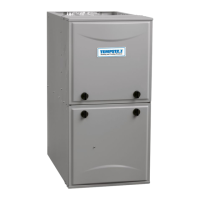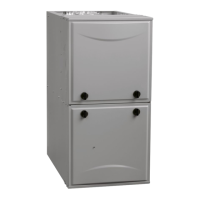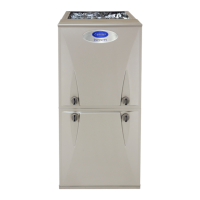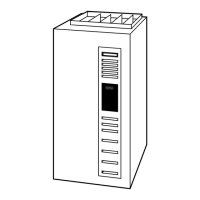F80CTL and G80CTL: Installation, Start–Up, Operating and Service and Maintenance Instructions
Manufacturer reserves the right to change, at any time, specifications and designs without notice and without obligations.
30
e. After component test is completed, one or more status codes
(heartbeat, 2+5) will flash. See component test section of service
label (Fig. 49) in furnace for explanation of status codes.
NOTE: To repeat component test, turn setup switch SW1-6 OFF, then
back ON.
5. Turn setup DIP switch SW1-6 OFF. Reconnect R lead to furnace
control board, release blower door switch and reinstall blower
access door.
6. Operate furnace per instruction on inner door.
7. Verify furnace shut down by lowering thermostat setting below
room temperature.
8. Verify furnace restarts by raising thermostat setting above room
temperature.
ADJUSTMENTS
A93059
Fig. 47 – Orifice Hole
Furnace gas input rate on rating plate is for installations at altitudes up to
2000 Ft. (610 M). Furnace input rate must be within +/-2 percent of
furnace rating plate input. For altitudes above 5500 Ft. (1676 M), a
field-supplied high altitude pressure switch is required. Perform the
following steps:
1. Determine the correct gas input rate.
The input rating for altitudes above 2,000 ft. (610 M) must be
reduced by 4 percent for each 1,000 ft. (305 M) above sea level.
For installations below 2000 Ft. (610 M), refer to the unit rating
plate. For installations above 2000 Ft. (610 M), multiply the input
on the rating plate by the de-rate multiplier in Table 10 for the
correct input rate.
2. Determine the correct orifice and manifold pressure adjustment. All
models in all positions except Low NOx models in downflow and
horizontal positions use Table 15 (22,000 Btuh per burner.) Low
NOx models in downflow or horizontal positions must use Table 16
(21,000 Btuh per burner.) See input listed on rating plate.
a. Obtain average yearly gas heat value (at installed altitude) from
local gas supplier.
b. Obtain average yearly gas specific gravity from local gas
supplier.
c. Find installation altitude in Tables 15 or 16.
d. Find closest natural gas heat value and specific gravity in Tables
15 or 16.
e. Follow heat value and specific gravity lines to point of
intersection to find orifice size and low-and high-heat manifold
pressure settings for proper operation.
f. Check and verify burner orifice size in furnace. NEVER
ASSUME ORIFICE SIZE. ALWAYS CHECK AND VERIFY.
NOTE: If orifice hole appears damaged or it is suspected to have been
redrilled, check orifice hole with a numbered drill bit of correct size.
Never redrill an orifice. A burr-free and squarely aligned orifice hole is
essential for proper flame characteristics.
g. Replace orifice with correct size, if required by Table 15 or
Table 16. Use only factory-supplied orifices. See Example
below.
3. Adjust manifold pressure to obtain low fire input rate, see Fig. 21.
a. Turn gas valve ON/OFF switch to OFF.
b. Remove manifold pressure tap plug from gas valve.
c. Connect a water column manometer or similar device to
manifold pressure tap.
d. Turn gas valve ON/OFF switch to ON.
e. Move setup SW1-2 on furnace control to ON position to lock
furnace in low-heat operation, see Table 14 and Fig. 32.
f. Manually close blower door switch.
g. Jumper R and W/W1 thermostat connections on control to start
furnace, see Fig. 32.
WARNING
!
FIRE HAZARD
Failure to follow this warning could result in personal injury, death
and/or property damage.
DO NOT bottom out gas valve regulator adjusting screw. This can
result in unregulated manifold pressure and result in excess overfire and
heat exchanger failures.
CAUTION
!
FURNACE DAMAGE HAZARD
Failure to follow this caution may result in reduced furnace life.
DO NOT redrill orifices. Improper drilling (burrs, out-of-round holes,
etc.) can cause excessive burner noise and misdirection of burner
flames. This can result in flame impingement of heat exchangers,
causing failures, see Fig. 47.
EXAMPLE: 0–2000 ft. (0-610 M) altitude
For 22,000 Btuh per burner application use Table 15.
Heating value = 1000 Btuh/cu ft.
Specific gravity = 0.62
Therefore: Orifice No. 43*
Manifold pressure: 3.7-In. W.C. for high-heat
1.6-In. W.C. for low-heat
* Furnace is shipped with No. 43 orifices. In this example all main burner orifices are the
correct size and do not need to be changed to obtain proper input rate.
Table 10 – Altitude Derate Multiplier for U.S.A.
ALTITUDE
FT. (M)
PERCENT
OF DERATE
DERATE MULTIPLIER
FACTOR*
0–2000
(0-610)
0 1.00
2001–3000
(610-914)
8–12 0.90
3001–4000
(914-1219)
12–16 0.86
4001–5000
(1219-1524)
16–20 0.82
5001–6000
1524-1829)
20–24 0.78
6001–7000
(1829-2134)
24–28 0.74
7001–8000
(2134-2438)
28–32 0.70
8001–9000
(2438-2743)
32–36 0.66
9001–10,000
(2743-3048)
36–40 0.62
